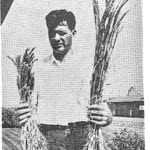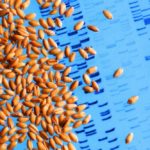The front page of our July 9, 1964 issue featured a photo of R. Glenn Anderson, a wheat breeder at the “rust lab” at the Department of Agriculture Cereal Research Station in Winnipeg. The photo illustrated the height difference between normal-height wheat and semi-dwarf wheat that Anderson had begun developing in 1956. That month Anderson











